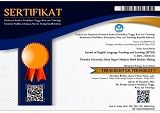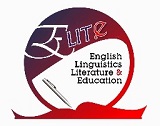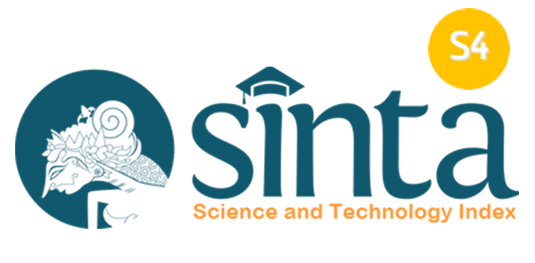Analysis of higher order thinking skills questions in reading exercises of "Bright" book for ninth grade
Abstract
Keywords
Full Text:
PDFReferences
Anderson, L. W., & Krathwohl, D. R. (2001). A taxonomy for learning, teaching and assessing - A Revision of Bloom's Taxonomy of Educational Objectives (Abridged E). Pearson Education
Aqeel, M., & Farrah, M. (2019). Eighth grade textbook reading comprehension questions and Barrett's Taxonomy: Teachers' perspectives at Hebron District, Palestine. Hebron University Research Journal (B), Humanities, 14(1), 229-260. http://dspace.hebron.edu:80/xmlui/handle/123456789/310
Aslan Altan, B. (2022). Students’ behavior of asking questions through narrative and informative texts. Journal of Education, 202(3), 320–329. https://doi.org/10.1177/00220574211043054
Brown, H. G & Abeywickrama, P. (2010). Language Assessment, principles and Classroom Practices, Second Edition. Pearson Education.
Budsankom, P., Sawangboon, T., Damrongpanit, S., & Chuensirimongkol, J. (2015). Factors affecting higher order thinking skills of students: A meta-analytic structural equation modeling study. Educational Research and Reviews, 10(19), 2639–2652. https://doi.org/10.5897/ERR2015.2371
Erdiana, N., & Panjaitan, S. (2023). How is HOTS integrated into the Indonesian high school English textbook? Studies in English Language and Education, 10(1), 60-77. https://doi.org/10.24815/siele.v10i1.26052
Febrina, F., Usman, B., & Muslem, A. (2019). Analysis of reading comprehension questions by using revised Bloom’s taxonomy on higher order thinking skill (HOTS). English Education Journal ,10(1) , 1-15. https://jurnal.unsyiah.ac.id/EEJ/article/view/13253
Freahat, N. M., & Smadi, O. M. (2014). Lower-order and higher-order reading questions in secondary and university level EFL textbooks in Jordan. Theory and Practice in Language Studies, 4(9), 1804-1813.
Gak, D. M. (2011).Textbook – An important element in the teaching process. Hatchaba Journal ,19(2),78-82https://doaj.org/article/1792f8e3edd84b958b1dff997fdc1f43
Hayati, S., Syahrudin, J., & Fitrawati, F. (2012). Level of question used in English textbook. Journal of English Language Teaching, 1(1), 119-128. https://doi.org/10.24036/jelt.v1i1.616
Istiqomah, F., & Maunah, B. (2020). An ESP textbook evaluation: The case of English for Islamic insight. Journal of English Language Teaching and Learning (JETLE), 1(2), Article 2. https://doi.org/10.18860/jetle.v1i2.8262
Laila, I., & Fitriyah, I. (2022). An analysis of reading comprehension questions in English textbook based on revised Bloom’s taxonomy. JET (Journal of English Teaching), 8(1), 71-83. https://doi.org/10.33541/jet.v8i1.3394
Lingard, J., Minasian‐Batmanian, L., Vella, G., Cathers, I., & Gonzalez, C. (2009). Do students with well‐aligned perceptions of question difficulty perform better? Assessment & Evaluation in Higher Education, 34(6), 603–619. https://doi.org/10.1080/02602930802287249
Lubliner, S. (2004). Help for struggling upper-grade elementary readers. International Literacy Association, 57(5), 430-438. https://www.jstor.org/stable/20205381
Knäuper, B., R.F. Belli, D.H. Hill, and A.R. Herzog. 1997. “Question difficulty and respondents’ cognitive ability: the effect on data quality.” Journal of Official Statistics 13(2): 181–199. Available At: https://www.scb.se/contentassets/ca21efb41-fee47d293bbee5bf7be7fb3/question-difficulty-and-respondents39-cognitive-ability-the-effect-on-data-quality.pdf.
Krippendorff, K. (1989). Content analysis. International encyclopedia of communication, 1(1), 403-407.
Margono, M. (2005). Metodologi penelitian pendidikan. Rineka Cipta. https://onesearch.id/Record/IOS3145.slims-5092
McTighe, J., & Wiggins, G. (2013). Essential questions: Opening doors to student understanding. Ascd.
Monari, Johnson M. (2020). Higher order question for higher order thinking skills. International Journal of Education and Research 8 (9), 1–8.
Noya, B. (2016). An analysis of reading questions in integrated course book based on the revised Bloom’s taxonomy theory (Doctoral dissertation, Program Studi Pendidikan Bahasa Inggris FBS-UKSW). http://repository.uksw.edu/handle/123456789/14418
Pei-Ju Sung, Su-Wei Lin, Pi-Hsia Hung (2015). Factors affecting item difficulty in English listening comprehension tests. Universal Journal of Educational Research, 3(7), 451 - 459. DOI: 10.13189/ujer.2015.030704
Pratiwi, N. U. R. (2014). Higher order thinking skill in reading exercise (an analysis of reading exercises in pathway to English textbook for the eleventh grade of senior high school students). The Syarif Hidayatullah State Islamic University. http://repository.uinjkt.ac.id/dspace/handle/123456789/25375
Putri, C. H. (2020). An analysis of reading questions in "English, stop bullying now" textbook by using revised Bloom's taxonomy. Unpublished Thesis. University Raden Intan Lampung. http://repository.radenintan.ac.id/id/eprint/18177
Sánchez, G., & Valcárcel, M. V. (1999). Science teachers' views and practices in planning for teaching. Journal of Research in Science Teaching: The Official Journal of the National Association for Research in Science Teaching, 36(4), 493-513. https://doi.org/10.1002/(SICI)1098-2736(199904)36:4<493::AID- TEA6>3.0.CO;2-P
Stoller, J. K., Taylor, C. A., & Farver, C. F. (2013). Emotional intelligence competencies provide a developmental curriculum for medical training. Medical teacher, 35(3), 243-247. https://doi.org/10.3109/0142159X.2012.737964
Tayyeh, M. N. (2021). An analysis of reading comprehension questions in English textbook" English For Iraq" according to Revised Bloom’s Taxonomy. Turkish Journal of Computer and Mathematics Education (TURCOMAT), 12(7), 2868- 2874. https://doi.org/10.17762/turcomat.v12i7.3880
Utami, F. D., Nurkamto, J., & Marmanto, S. (2019). Higher-order thinking skills on test items designed by English teachers: A content analysis. International Journal of Educational Research Review, 4, 756-765.
Wang, W. (2011). A content analysis of reliability in advertising content analysis studies. East Tennessee State University Digital Commons, 40. Retrieved from https://dc.etsu.edu/etd/1375
Wiranegara, D. A. (2022). Implementing SSS (start with simple stories) method to improve students’ reading comprehension in extensive reading activity. Journal of English for Academic and Specific Purposes (JEASP), 5(1). https://doi.org/10.18860/jeasp.v5i1.16583
Zaida, N. (2016). BRIGHT 3 an English course for SMP/MTS/KM. Erlangga.
DOI: https://doi.org/10.18860/jetle.v6i1.30849
Refbacks
- There are currently no refbacks.
Jalan Gajayana 50 Malang 65144, Jawa Timur, Indonesia

This work is licensed under a Creative Commons Attribution-ShareAlike 4.0 International License.
Indexed by






